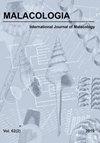Intraspecific Variation in the Common Pea Clam, Pisidium casertanum (Poli, 1791) (Bivalvia: Sphaeriidae): A Geometric Morphometric Analysis
IF 1
4区 生物学
Q4 ZOOLOGY
引用次数: 1
Abstract
ABSTRACT The morphological plasticity of bivalve species may impair their correct identification. Pisidium species (Sphaeriidae) are difficult to distinguish, notably the common pea clam, Pisidium casertanum (Poli, 1791), which is a polymorphic species, often misidentified and confused with other Pisidium species. This is especially true since this species is the most euryecious of the genus, being able to colonize very different habitats. In this study, elliptic Fourier Analysis, a geometric morphometric method, was used to assess intraspecific variation in P. casertanum. Sampling of specimens was done in three habitat types – springs, lakes and streams – in the Mediterranean biodiversity hotspot region, using the Sebou basin in Morocco as a study area. In addition to the geometric morphometric method, linear measurements of the shell were used to assess growth patterns. Results revealed differences in the hinge plate, which is broader in shells collected from lakes, whereas it is higher in shells of springs. The geometric morphometric method clearly showed shape differences between individuals of the three habitats. Specimens of lakes were the most distinguishable, presenting more elongated shells than those from springs and streams, which are shorter but higher. Individuals from the three habitat types presented a negative allometric growth pattern whereby the shell of animals grows more slowly in height than in length. The use of linear and geometric morphometric methods led to conclude that the morphology of P. casertanum is, in fact, highly influenced by its environment, in particular, its habitat type.普通豌豆蛤的种内变异,Pisidium casertanum (Poli, 1791)(双壳目:球形蛤科):几何形态计量学分析
双壳类物种的形态可塑性可能会影响它们的正确识别。豌豆蛤(Sphaeriidae)很难区分,尤其是常见的豌豆蛤,干酪豌豆蛤(Poli,1791),它是一种多态性物种,经常被误认,并与其他豌豆蛤物种混淆。这一点尤其正确,因为该物种是该属中最具私欲的物种,能够在非常不同的栖息地定居。在本研究中,椭圆傅立叶分析是一种几何形态计量方法,用于评估干酪乳杆菌的种内变异。以摩洛哥塞布盆地为研究区域,在地中海生物多样性热点地区的三种栖息地类型——泉水、湖泊和溪流——进行了标本采样。除了几何形态测量方法外,还使用外壳的线性测量来评估生长模式。结果显示,铰链板的差异,从湖泊收集的贝壳中铰链板更宽,而在弹簧的贝壳中则更高。几何形态计量方法清楚地显示了三个栖息地个体之间的形状差异。湖泊的标本是最明显的,呈现出比泉水和溪流更细长的外壳,泉水和溪流更短但更高。来自三种栖息地类型的个体呈现出负的异速生长模式,即动物外壳的高度比长度生长得慢。使用线性和几何形态计量方法得出结论,事实上,干酪乳杆菌的形态受到其环境,特别是栖息地类型的高度影响。
本文章由计算机程序翻译,如有差异,请以英文原文为准。
求助全文
约1分钟内获得全文
求助全文
来源期刊

Malacologia
生物-动物学
CiteScore
2.00
自引率
0.00%
发文量
15
审稿时长
3 months
期刊介绍:
Malacologia publishes papers on all groups of the Mollusca. Malacologia specializes in publishing long papers and monographic treatments. Complete data are especially appreciated. Papers must be of interest to an international readership. Papers in systematics, ecology, population ecology, genetics, molecular genetics, evolution and phylogenetic treatments are especially welcomed. Also welcomed are letters to the editor involving papers published or issues of import to science of the day.
 求助内容:
求助内容: 应助结果提醒方式:
应助结果提醒方式:


